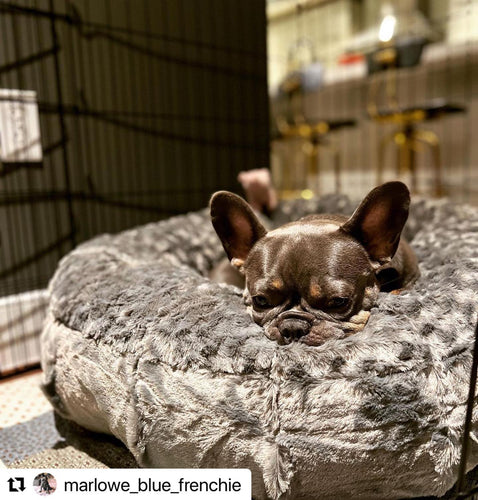How to Get Your Dog to Love Their Dog Crate

Being a pet parent can be tough, especially if you're going through the dreaded potty training session with your puppy. But crates can be used to make both your lives easier. In addition, a dog crate can become a safe space for your puppy or older dog as they get used to living in a new environment. But how exactly do you get your dog to love their crate? Here are some tips to get you started.
Why Should You Use a Dog Crate?
Dogs may be domesticated, but they still have the same instincts that helped them survive for so many years. This includes desiring a small space, sort of like a den. They'll naturally seek out a den in your home.
By using a crate or a kennel, you provide them with the safe place they are already seeking. It's also a great way to work on dog training. Start with these crucial tips:
1. Choose the Right Size
Dog crates that are too small will leave your pup feeling anxious and cramped. This can be difficult when your dog is still growing, as you may feel like you have to buy several crates. If you know your dog's breed and have an idea of its size, it's easy enough to get them a dog crate that will suit your dog's needs as they grow into adulthood. This is an entirely different story for those who have new puppies and have no idea what breed they are.
With that in mind, The Humane Society recommends that you get a crate large enough for your dog to stand up and turn around. It's also important that your dog be able to lie down.
2. Don't Rush the Process
Crate training takes time. If you try to rush it, your pup may develop a negative association with its crate. In fact, it can take weeks to get them used to it, and getting them to stay in for at least two minutes may seem like a major victory. So treat it like it is, and continue to give your dog love as they learn to feel comfortable in their crate.
Start with short periods of time. You need to stay with them while you do so, at least at first. You should never leave the house with your dog in the crate until it can handle it for at least thirty minutes.
3. Put Their Favorite Toys Inside
By placing your dog's favorite squeaky or kong toy filled with peanut butter, you can teach your dog that the crate is its own place. It's OK if it drags them out. When you clean up after your dog, just toss the toys back inside.
Chew toys are great for when you have to put your dog in for extended periods of time, such as when you head to the grocery store or are going out to see the latest rom-com in theaters. Puzzle toys are also great for keeping their attention elsewhere, and blankets can help them feel even more comfortable.
Tips to Avoid
You should never use a crate as a source of punishment. They're great for things like house training, handling separation anxiety, and potty training. You want your dog to have a positive association with its dog crate, but if you use it to punish your dog, then you're defeating the purpose. If your pooch has extreme behaviors, you should consider working with a dog trainer.
You should also avoid leaving them in their crate for longer periods of time.
Also, don't close the crate door the second they get in. Instead, let them go in and out without having the door close at first. This will let them become accustomed to going in.
Not All Dogs Will Accept Crates
This is just a fact of life, especially for adult dogs who have been rescued. Unfortunately, you have no idea what happened before they joined your family. With that in mind, you may need to speak to a dog trainer about working with your dog. They'll be able to offer training tips to help teach your dog.
A behaviorist may recommend positive reinforcement training, such as using a clicker. According to the American Kennel Club, "A clicker (or marker) is a tool that can make positive reinforcement training more efficient. After being repeatedly associated with a treat or reward, a clicker becomes a conditioned reinforcer." But if your dog is willing to accept a dog crate, don't hesitate to use it.
FAQs
What do I do if my dog hates his crate?
Some dogs will never accept dog crates, and that's OK. This could be because of past events you aren't aware of, or it could even have to do with the fact that they simply don't like small spaces. Whatever the reason, there are other options out there to train your dog. A dog behaviorist can give you more tips.
How long does it take for a dog to get used to crate training?
While the answer you're doubtless looking for is that it can be done in just a few hours, the truth is that the crate training process takes time. Depending on your dog, it may take a few weeks or months.
By using short periods of time in the crate, you can make the dog feel safe rather than trapped. Then you increase the time. Don't hesitate to use bribes, and make it clear that this is their space. Also, don't make them stay inside for long lengths of time. This will make them feel trapped, which is the complete opposite of comfortable.
What are some ways to make my dog's crate more comfortable?
There's no point in using a crate if your dog is uncomfortable. To do this, they need to know that it's their safe place.
You can add their favorite dog bed or a special crate pad, as well as their favorite toy. Kong toys filled with treats will make your dog a very happy pooch.
Are you looking for the perfect dog bed to include in their crate? If so, all our products are designed using only high-quality materials. Check out our site to learn more.
Subscribe
Sign up to get the latest on sales, new releases and more…
Categories
- Tails of Celebration: Working Dogs of the Lares Trek, A Silent Partnership In Peru
- 5 Easy Organic Christmas Recipes for Dogs: Simple Holiday Treats Your Companion Will Love
- The 6 Best Luxury Gifts for Your Dog This Christmas: Thoughtful Holiday Comfort That Truly Lasts
- Why Playtime Matters: The Benefits of Mental Stimulation and Playtime with Your Companion
- Tails of Celebration: The Miao Dog-Carrying Festival - A Hero's Honor in China
- A Dog-Friendly Thanksgiving 2025: Comfort, Calm, and Easy Treat Recipes
- The Best Dog Beds for Winter 2025: 5 Luxury Styles for Warmth, Comfort & Orthopedic Support
- Tails of Celebration: The Feast of Saint Hubert — Belgium's Timeless Blessing
- Halloween Safety Tips for Dogs: How to Keep Your Companion Safe This Spooky season
- Tails of Celebration: Día de los Muertos / Day of the Dead for Pets, A Festival of Memory in Mexico
- How to Care for Senior Dogs in Fall: Mobility Tips & Joint Support
- Tails of Celebration: Kukur Tihar & The Tihar Festival of Nepal
- What is a VDI Testing for dogs ? : Insights, Procedures and Preventive Measures
- Cheap Dog Beds vs. Luxury Dog Beds: The Real Cost of a $50 "Disposable" Dog Bed
- Can Dogs Have OCD? Understanding Canine Compulsive Behaviors (CCD)
- Does My Dog Like Music? Find Out What Tunes Make Your Pup Wag!
- Effective Solutions for Food Aggression in Dogs
- 7 Frozen Treats Your Dog Will Love This Summer☀️🧊🍉
- The Best Waterproof Liners for Dog Beds: Protect Against Spills, Drool, and Accidents
- How to Cope with the Loss of a Dog: A Tribute to Every Companion We Carry in Our Hearts
- Top Tips on How to Prevent Matting in Dogs
- Understanding and Managing Dogs with Hip Dysplasia
- The Ultimate Guide to Dog Gut Health: Natural Remedies, Probiotic Insights and Signs of Poor Gut Health
- The Best Supplements for Dogs: Explore Top Picks for Canine Health and Wellness
- How Often Should I Brush My Dog's Teeth? Tips for Optimal Canine Dental Health
- Ultimate Guide on How to Comfort Your Dog During Fireworks this 4th of July
- Managing a Blowing Coat: Essential Grooming Tips for Double-Coated Dogs.
- 5 Daily Habits That Boost Your Dog’s Long-Term Wellness
- Mastering Crate Training a Dog: Tips and Benefits
- Dog Car Seats vs. Seat Covers: What’s The Best Option For Your Companion?
- Best Outdoor Dog Beds: Luxury, Durability, and Unmatched Comfort
- Is My Dog Overweight? Tips to Assess and Help Your Companion
- The Best Faux Fur Dog Beds for Ultimate Pet Comfort of 2025
- Dog Running Guide: How to Start, Train & Stay Safe when running with your Dog
- Indestructible Dog Beds? The Truth Behind the Term
- Top Tips for Effective Exercise for Dogs
- Effective Dog Ear Cleaning: A Step-by-Step Guide for Maintaining Healthy Ears
- How to Manage Dog Aggressive Behaviors: Expert Tips and Advice
- Effective Canine Ear Infection Remedies: Symptoms, Causes & Treatments
- How to Make a New Dog Comfortable in Their New Home - 2025 Guide
- Signs of Dog Allergy Symptoms and How to Help and Prevent Them
- Why Does My Dog Lick Their Paws? Causes and Solutions Explained
- Dog Alzheimer's: Symptoms, Causes, and Treatment Options
- The Legacy of Comfort with the Iconic Animals Matter® Ortho Companion-Pedic® Puff Luxury Dog Bed
- Orthopedic Square Dog Beds: The Ultimate Blend of Luxury, Comfort, and Support
- Loungers: The Ultimate Beds for Luxury, Comfort, and Orthopedic Support
- Square Dog Beds: Orthopedic Comfort and Stylish Designs for Your Companion
- Effective Solutions for Canine Incontinence: Identifying Causes and Best Treatments
- Ethical, Sustainable, and Certified: Why Certified Products Matter, Exploring CA Prop 65 and CertiPUR-US® Standards
- Dog Seizures: Signs, Causes, and How to Help Dogs with Seizures


Leave a comment
Please note, comments must be approved before they are published